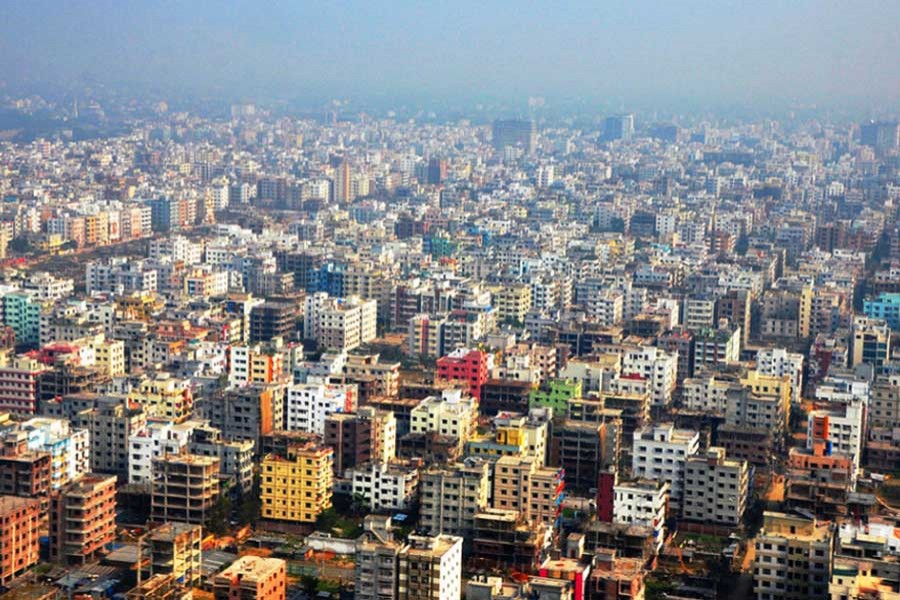
Published :
Updated :

The average temperature of Dhaka city remains 2.0 degrees Celsius higher than that of rural areas in summer and monsoon, a new study has found.
Its temperature has been increasing over time with the rapid pace of urban growth, vehicular movement, and declining vegetation and water bodies.
The results of the temperature of the megacity and its nearby rural areas derived from installing machines are consistent with an estimated 17,000 satellite images.
Dhaka city's temperature remains higher at night-time than rural areas, reveals the study.
Temperature rise in planned areas (like Gulshan and Uttara) is higher than unplanned areas as construction materials trap heat and high use of cooling technology.
The density of buildings, population, transportation and a lack of green-blue spaces are mainly responsible for heating, according to the study.
The problem of urban heat island (UHI) effects has hardly attracted policy attention so far in the policy documents, it noted.
The findings were disclosed at a seminar on 'Mitigation Strategies for Warming of Dhaka Megacity: Implications for Sustainable Development' at Bangladesh Institute for International and Strategic Studies (BIISS).
BIISS, Meteorology Department of Dhaka University and Curtain University of Australia jointly conducted the research funded by the World Bank.
Shamsul Alam, senior secretary and member of general economics division of planning commission, was present there as the special guest.
Prof Ashraf Dewan of the School of Earth and Planetary Sciences of Curtain University and BIISS research director Mahfuz Kabir presented the findings.
Mr Dewan said urban temperature is rising faster than expected, especially at daytime. Heating is related to public health hazards like dengue and other fevers.
River, lake, park, wayside tree and water fountain provide a significant thermal comfort, he added.
But built-up areas increased to 34.2 per cent in 2017 from 6.5 per cent in 2000, Mr Dewan said, adding that such areas are consistently experiencing high heat.
Temperature is higher in planned areas like Gulshan due to the excessive use of air conditioning.
He talked about roof garden that can reduce temperature up to 4.7 degrees and also recommended removing plastic billboards and signs.
Micro-green spaces in buildings also provide thermal comfort and create a positive impact on productivity. It is also a good source of food, fruit, flower and recreation, he added.
Speakers said important policy documents like Bangladesh Climate Change Strategy and Action Plan 2009, Bangladesh Climate Public Expenditure and Institutional Review, Bangladesh Climate Fiscal Framework and Seventh Five-Year Plan have mentioned environmental problems in Dhaka and urban areas.
The problems include air and noise pollution, waterlogging, lack of vegetation and biodiversity, and drying and contaminated open water bodies including ponds, canals and surrounding rivers.
However, they have not mentioned about the UHI effect on any urban areas and relevant mitigation strategies.
The Bangladesh Delta Plan 2100 has, however, recognised it as a problem and suggested policy measures to reduce or mitigate this effects.
Large urban parks, in addition to facilitating public recreation, are providing space for water storage and balance, contributing to the general quality of urban life and maintaining ecological values.
Strategic development of functional green-blue spaces that include retention areas and canals should be accompanied by effective and properly enforced spatial planning system, the study suggested.
Prof Ruhul Salim of the School of Economics, Finance and Property of Curtain University said the authorities here have failed to build another Ramna Park and Suhrawardy Udyan in Bangladesh.
In Dhaka, not only high rise buildings have increased over the past three decades but also blue and green networks have reduced, he cited.
International Centre for Climate change and development director Saleemul Huq said future Dhaka is wrongly expanding towards east. It is time to stop and rectify those mistakes.
Acknowledging the failure to create another Ramna Park, Shamsul Alam said any space for park might have been packed with so many concrete buildings now.
He warned against popularising roof garden, considering the excess water use to grow plants on rooftops and future consequence.
Mr Alam rather suggested harvesting rainwater and encouraging people to use less groundwater.
BIISS chairman Ambassador M Fazlul Karim said filling up wetlands and canals are some of the major reasons behind temperature rise in Dhaka.
But many cities in the world are investing in forests, wetlands and other green areas, he added.
Mr Karim suggested shifting large factories outside Dhaka gradually and location-based mitigation strategies along with a holistic approach.
msshova@gmail.com


 For all latest news, follow The Financial Express Google News channel.
For all latest news, follow The Financial Express Google News channel.